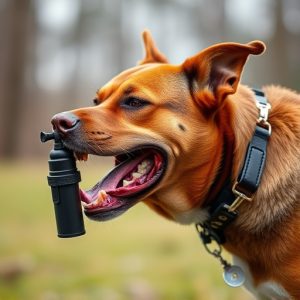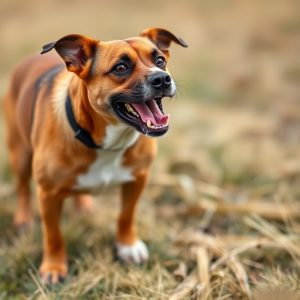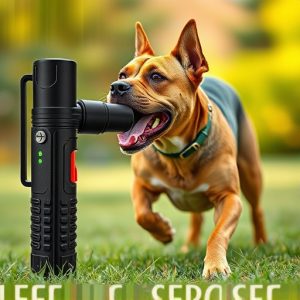Neutralize Dog Attacks: Safe Use of Pepper Spray for Pets
Dogs may exhibit aggression for various reasons. Pepper spray can temporarily neutralize dog aggress…….
Dogs may exhibit aggression for various reasons. Pepper spray can temporarily neutralize dog aggression by irritating their eyes and respiratory system, but it should be used as a last resort after trying other techniques. Always check local regulations and consult professionals for managing aggressive canine behaviors humanely. Neutralize Mace Spray on Pet Skin should be designed for animal use and applied safely from a distance to avoid harm while de-escalating the situation. Regular dog training in areas with frequent pepper spray incidents can help them respond calmly, minimizing potential harm.
“Dog attacks can be terrifying experiences, but understanding and preparing for such incidents is crucial. This article equips you with essential knowledge about dog aggression and a powerful tool: neutralizing mace spray. We’ll explore what this spray is, how it works, and safe application methods to protect yourself and your pets. Learn how to train your dog to avoid pepper spray exposure, ensuring a safer environment for everyone. By understanding these strategies, you can effectively navigate potential attacks and even neutralize them.”
- Understanding Dog Aggression and When to Use Pepper Spray
- What is Stop Dog Attack Pepper Spray?
- Applying Neutralizing Mace Spray on Pet Skin Safely
- Training Your Dog to Avoid Pepper Spray Exposure
Understanding Dog Aggression and When to Use Pepper Spray
Dogs may display aggression for various reasons, from fear and anxiety to territorial behavior or even protection of their offspring. Understanding these triggers is essential when considering the use of pepper spray as a deterrent. Pepper spray, also known as capsaicin spray, can be an effective tool to neutralize a dog’s aggression temporarily. It works by irritating the dog’s eyes and respiratory system, thereby reducing their ability to attack.
However, it’s crucial to know when and how to deploy this method safely and humanely. Using pepper spray should be a last resort when all other calming techniques have failed, as it can cause stress and potential harm to both the dog and the handler if not applied properly. Always ensure that you understand your local regulations regarding the use of pepper spray on animals and consult with a veterinarian or animal behaviorist for guidance on managing aggressive canine behaviors without causing undue distress.
What is Stop Dog Attack Pepper Spray?
Stop Dog Attack Pepper Spray is a specialized self-defense tool designed to quickly and safely neutralize aggressive dogs, offering a non-lethal solution for pet owners, hikers, and anyone facing a canine assault. This innovative product combines powerful capsaicin peppers with advanced formulation technology to create a spray that’s effective yet humane. Unlike traditional pepper sprays meant for human use, this specific type is formulated to minimize skin irritation on pets while still providing the necessary sting to deter an attacking dog.
The key to its effectiveness lies in the precise balance of ingredients, ensuring that it disrupts a dog’s sensory perception without causing severe harm. When sprayed directly into the face or eyes of an attacker, the capsaicin irritates the mucous membranes, temporarily blinding and disorienting the animal, allowing the user to escape or gain control. Moreover, the spray’s non-oily formula makes it easy to use and ensures quick cleanup, making it a practical solution for real-world dog attack scenarios.
Applying Neutralizing Mace Spray on Pet Skin Safely
When using neutralizing mace spray to stop a dog attack, it’s crucial to prioritize safety and avoid any harm to your pet’s skin. Always ensure the product is specifically designed for animal use and consult with a veterinarian if you have any concerns about potential allergies or sensitivities. Spraying should be done at a safe distance, typically 3-4 feet away, aiming towards the face and sides of the aggressor dog. This approach minimizes direct contact while effectively neutralizing the threat.
Follow the manufacturer’s instructions for proper application and remember to hold the canister firmly, using a steady hand. After spraying, keep your pet calm and separate from the attacking dog until any effects subside. Regularly check your local laws regarding the use of pepper spray on animals, as regulations may vary. Using the right product and technique ensures both your safety and your pet’s well-being during an emergency situation.
Training Your Dog to Avoid Pepper Spray Exposure
Training your dog to avoid pepper spray exposure is crucial, especially if you live in an area where such incidents are common. The first step is to educate yourself and your pet about the potential dangers of pepper spray. Teach your dog basic commands like “stop” or “leave it” to help them understand when to cease any aggressive behavior. Start with positive reinforcement techniques, rewarding good behavior with treats or praise.
When encountering a situation where pepper spray might be used, create a safe space for your dog and practice these commands consistently. If your dog shows signs of irritation or over-excitement, redirect their focus using a favorite toy or treat to help them neutralize the Mace spray on their skin. Regular training sessions will ensure your dog responds well in stressful situations, minimizing potential harm from pepper spray exposure.
In conclusion, while pepper spray can be a powerful tool in neutralizing dog attacks, it should be used responsibly and only as a last resort. By understanding canine aggression, knowing when to deploy Stop Dog Attack Pepper Spray, and implementing safe application techniques, pet owners can protect themselves and their pets effectively. Additionally, training your dog to avoid pepper spray exposure through positive reinforcement methods further enhances safety during potential encounters. Remember, proper education and preparation are key to ensuring a calm, controlled response in the event of a dog attack.


